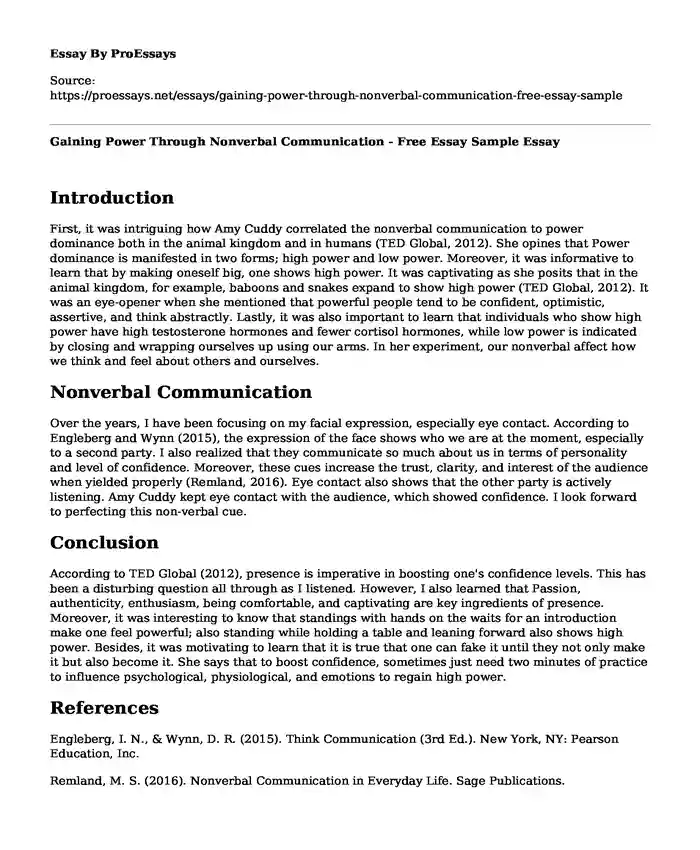Introduction
First, it was intriguing how Amy Cuddy correlated the nonverbal communication to power dominance both in the animal kingdom and in humans (TED Global, 2012). She opines that Power dominance is manifested in two forms; high power and low power. Moreover, it was informative to learn that by making oneself big, one shows high power. It was captivating as she posits that in the animal kingdom, for example, baboons and snakes expand to show high power (TED Global, 2012). It was an eye-opener when she mentioned that powerful people tend to be confident, optimistic, assertive, and think abstractly. Lastly, it was also important to learn that individuals who show high power have high testosterone hormones and fewer cortisol hormones, while low power is indicated by closing and wrapping ourselves up using our arms. In her experiment, our nonverbal affect how we think and feel about others and ourselves.
Nonverbal Communication
Over the years, I have been focusing on my facial expression, especially eye contact. According to Engleberg and Wynn (2015), the expression of the face shows who we are at the moment, especially to a second party. I also realized that they communicate so much about us in terms of personality and level of confidence. Moreover, these cues increase the trust, clarity, and interest of the audience when yielded properly (Remland, 2016). Eye contact also shows that the other party is actively listening. Amy Cuddy kept eye contact with the audience, which showed confidence. I look forward to perfecting this non-verbal cue.
Conclusion
According to TED Global (2012), presence is imperative in boosting one's confidence levels. This has been a disturbing question all through as I listened. However, I also learned that Passion, authenticity, enthusiasm, being comfortable, and captivating are key ingredients of presence. Moreover, it was interesting to know that standings with hands on the waits for an introduction make one feel powerful; also standing while holding a table and leaning forward also shows high power. Besides, it was motivating to learn that it is true that one can fake it until they not only make it but also become it. She says that to boost confidence, sometimes just need two minutes of practice to influence psychological, physiological, and emotions to regain high power.
References
Engleberg, I. N., & Wynn, D. R. (2015). Think Communication (3rd Ed.). New York, NY: Pearson Education, Inc.
Remland, M. S. (2016). Nonverbal Communication in Everyday Life. Sage Publications.
TED Global. (2012). Amy Cuddy: Your Body Language Shapes Who You Are. Retrieved from http://www.ted.com/talks/amy_cuddy_your_body_language_shapes_who_you_are
Cite this page
Gaining Power Through Nonverbal Communication - Free Essay Sample. (2023, Nov 02). Retrieved from https://proessays.net/essays/gaining-power-through-nonverbal-communication-free-essay-sample
If you are the original author of this essay and no longer wish to have it published on the ProEssays website, please click below to request its removal:
- Communication Studies Essay Example
- Why I Want to Be a Paralegal Essay Example
- Biography and Successes of Jeff Bezos Paper Example
- Intercultural Communication & Negotiation: Adapting Skills in a Global Setting - Essay Sample
- School Counseling: A Tool for Shaping the Future - Essay Sample
- Essay Example on Community-Based Correction: Decarceration for Prison Overcrowding
- Essay Example on Sociological Theory: Analyzing Society's Structures & Relationships







